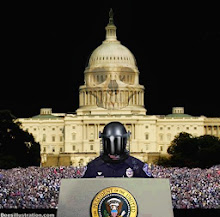24 September 2011
Why time travel is possible
by John Gribbin
from JohnGribbin Website
Physicists have found the law of nature which prevents time travel paradoxes, and thereby permits time travel. It turns out to be the same law that makes sure light travels in straight lines, and which underpins the most straightforward version of quantum theory, developed half a century ago by Richard Feynman.
Relativists have been trying to come to terms with time travel for the past seven years, since Kip Thorne and his colleagues at Caltech discovered -- much to their surprise - that there is nothing in the laws of physics (specifically, the general theory of relativity) to forbid it. Among several different ways in which the laws allow a time machine to exist, the one that has been most intensively studied mathematically is the "wormhole".
This is like a tunnel through space and time, connecting different regions of the Universe -- different spaces and different times. The two "mouths" of the wormhole could be next to each other in space, but separated in time, so that it could literally be used as a time tunnel.
Building such a device would be very difficult - it would involve manipulating black holes, each with many times the mass of our Sun. But they could conceivably occur naturally, either on this scale or on a microscopic scale.
The worry for physicists is that this raises the possibility of paradoxes, familiar to science fiction fans. For example, a time traveler could go back in time and accidentally (or even deliberately) cause the death of her granny, so that neither the time traveler's mother nor herself was ever born.
People are hard to describe mathematically, but the equivalent paradox in the relativists' calculations involves a billiard ball that goes in to one mouth of a wormhole, emerges in the past from the other mouth, and collides with its other self on the way in to the first mouth, so that it is knocked out of the way and never enters the time tunnel at all. But, of course, there are many possible "self consistent" journeys through the tunnel, in which the two versions of the billiard ball never disturb one another.
If time travel really is possible - and after seven years' intensive study all the evidence says that it is - there must, it seems, be a law of nature to prevent such paradoxes arising, while permitting the self- consistent journeys through time.
Igor Novikov, who holds joint posts at the P. N. Lebedev Institute, in Moscow, and at NORDITA (the Nordic Institute for Theoretical Physics), in Copenhagen, first pointed out the need for a "Principle of Self-consistency" of this kind in 1989 (Soviet Physics JETP, vol 68 p 439).
Now, working with a large group of colleagues in Denmark, Canada, Russia and Switzerland, he has found the physical basis for this principle.
It involves something known as the Principle of least action (or Principle of minimal action), and has been known, in one form or another, since the early seventeenth century. It describes the trajectories of things, such as the path of a light ray from A to B, or the flight of a ball tossed through an upper story window. And, it now seems, the trajectory of a billiard ball through a time tunnel.
Action, in this sense, is a measure both of the energy involved in traversing the path and the time taken. For light (which is always a special case), this boils down to time alone, so that the principle of least action becomes the principle of least time, which is why light travels in straight lines.
You can see how the principle works when light from a source in air enters a block of glass, where it travels at a slower speed than in air. In order to get from the source A outside the glass to a point B inside the glass in the shortest possible time, the light has to travel in one straight line up to the edge of the glass, then turn through a certain angle and travel in another straight line (at the slower speed) on to point B.
Traveling by any other route would take longer.
The action is a property of the whole path, and somehow the light (or "nature") always knows how to choose the cheapest or simplest path to its goal. In a similar fashion, the principle of least action can be used to describe the entire curved path of the ball thrown through a window, once the time taken for the journey is specified. Although the ball can be thrown at different speeds on different trajectories (higher and slower, or flatter and faster) and still go through the window, only trajectories which satisfy the Principle of least action are possible.
Novikov and his colleagues have applied the same principle to the "trajectories" of billiard balls around time loops, both with and without the kind of "self collision" that leads to paradoxes.
In a mathematical tour de force, they have shown that in both cases only self-consistent solutions to the equations satisfy the principle of least action - or in their own words,
"the whole set of classical trajectories which are globally self-consistent can be directly and simply recovered by imposing the principle of minimal action"
(NORDITA Preprint, number 95/49A)
The word "classical" in this connection means that they have not yet tried to include the rules of quantum theory in their calculations. But there is no reason to think that this would alter their conclusions.
Feynman, who was entranced by the principle of least action, formulated quantum physics entirely on the basis of it, using what is known as the "sum over histories" or "path integral" formulation, because, like a light ray seemingly sniffing out the best path from A to B, it takes account of all possible trajectories in selecting the most efficient.
So self-consistency is a consequence of the Principle of least action, and nature can be seen to abhor a time travel paradox. Which removes the last objection of physicists to time travel in principle - and leaves it up to the engineers to get on with the job of building a time machine.
Labels:
COSMIC SPHERES OF TIME,
Discoveries,
Fractal Universe,
Hidden Portal,
Holographic Universe,
Hyperspace,
Multiverse,
Parallel Universes,
Quantum Reality,
Time Capsule,
Time Machine
Subscribe to:
Post Comments (Atom)






































No comments:
Post a Comment